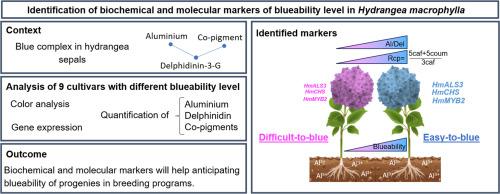Identification of biochemical and molecular markers of blueability level in Hydrangea macrophylla
IF 4.2
2区 农林科学
Q1 HORTICULTURE
引用次数: 0
Abstract
In Hydrangea macrophylla cultivars with pink inflorescences, sepals can turn blue in the presence of aluminium (Al). While the formation of the blue complex is well understood, the mechanisms behind variable blueing in pink cultivars remain unclear and this lack of knowledge makes difficult reliably breeding new varieties with good blueability. To investigate this, we studied nine pink cultivars exhibiting different levels of blueability. Sepal color changes after Al supply were used to classify cultivars along a blueability scale. We then assessed Al absorption, transport, and translocation by measuring Al content in vegetative organs and inflorescences, and by analysing the expression of related genes. We also quantified delphinidin (Del) and co-pigment accumulation in inflorescences. Our results show that changes in hue following Al supply are a reliable indicator of blueability. High blueability correlates with both a high Al/Del ratio and a high ratio of stabilizing (5-caffeoylquinic acid + 5-coumaroylquinic acid) to destabilizing (3-caffeoylquinic acid) co-pigments in sepals—defined as the Rcp ratio. Poor blueability is observed when either ratio is below threshold values (Al/Del < 10; Rcp < 0.5). Additionally, the expression of HmCHS (anthocyanin biosynthesis), HmALS3 (Al transport), and HmMYB2 (phenylpropanoid pathway regulator) positively correlates with blueability, suggesting their key roles in regulating blue coloration. Notably, HmALS3 expression in vegetative organs correlates with blueability several months before flowering. Our results provide a valuable program for accelerating blue cultivar screening, saving cultivation space and time: Since the Rcp ratio remains stable regardless of Al supply, it can serve as an early selection marker during the first flowering year, even without Al treatment. Then, measurement of ALS3 expression in the vegetative organs of the selected progenies under Al supply and well before flowering would complete this early screening. Finally, measurement of the [Al]/[Del] ratio in sepals upon flowering and assessment of the blue color at full blooming would confirm good blueability of the few preselected genotypes.

大绣球蓝度生化及分子标记的鉴定
在花序为粉红色的绣球品种中,萼片在铝(Al)的存在下会变成蓝色。虽然蓝色复合体的形成已经被很好地理解,但粉红色品种变蓝背后的机制仍然不清楚,这种知识的缺乏使得难以可靠地培育出具有良好蓝性的新品种。为了研究这一点,我们研究了9个表现出不同蓝度的粉红色品种。用补铝后萼片颜色的变化来划分品种的蓝度。然后,我们通过测量营养器官和花序中的铝含量以及分析相关基因的表达来评估铝的吸收、运输和易位。我们还量化了飞燕草苷(Del)和共色素在花序中的积累。我们的研究结果表明,随着铝的供应,颜色的变化是蓝度的可靠指标。高蓝度与萼片中稳定(5-咖啡酰奎宁酸+ 5-香豆素酰奎宁酸)与不稳定(3-咖啡酰奎宁酸)共色素的高比值(定义为Rcp比)相关。当任何一个比值低于阈值(Al/Del < 10; Rcp < 0.5)时,可观察到较差的蓝度。此外,HmCHS(花青素生物合成)、HmALS3(铝转运)和HmMYB2(苯丙素途径调节剂)的表达与蓝性呈正相关,表明它们在调控蓝色中起关键作用。值得注意的是,在开花前几个月,营养器官中HmALS3的表达与蓝度相关。我们的研究结果为加速蓝色品种筛选,节省栽培空间和时间提供了有价值的方案:由于Rcp比在没有Al处理的情况下保持稳定,因此即使在第一个开花年份,Rcp比也可以作为早期选择标记。然后,在铝供应和开花前测定所选后代营养器官中ALS3的表达量,完成早期筛选。最后,通过花期萼片[Al]/[Del]比值的测定和盛开时的蓝色评价,证实了少数预选基因型具有良好的蓝性。
本文章由计算机程序翻译,如有差异,请以英文原文为准。
求助全文
约1分钟内获得全文
求助全文
来源期刊

Scientia Horticulturae
农林科学-园艺
CiteScore
8.60
自引率
4.70%
发文量
796
审稿时长
47 days
期刊介绍:
Scientia Horticulturae is an international journal publishing research related to horticultural crops. Articles in the journal deal with open or protected production of vegetables, fruits, edible fungi and ornamentals under temperate, subtropical and tropical conditions. Papers in related areas (biochemistry, micropropagation, soil science, plant breeding, plant physiology, phytopathology, etc.) are considered, if they contain information of direct significance to horticulture. Papers on the technical aspects of horticulture (engineering, crop processing, storage, transport etc.) are accepted for publication only if they relate directly to the living product. In the case of plantation crops, those yielding a product that may be used fresh (e.g. tropical vegetables, citrus, bananas, and other fruits) will be considered, while those papers describing the processing of the product (e.g. rubber, tobacco, and quinine) will not. The scope of the journal includes all horticultural crops but does not include speciality crops such as, medicinal crops or forestry crops, such as bamboo. Basic molecular studies without any direct application in horticulture will not be considered for this journal.
 求助内容:
求助内容: 应助结果提醒方式:
应助结果提醒方式:


